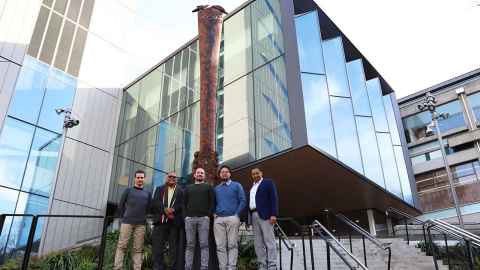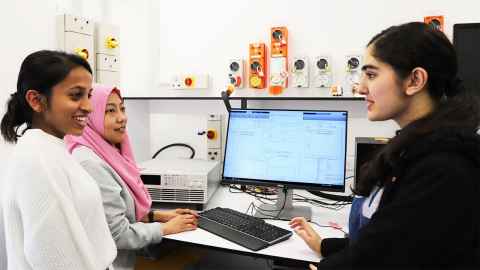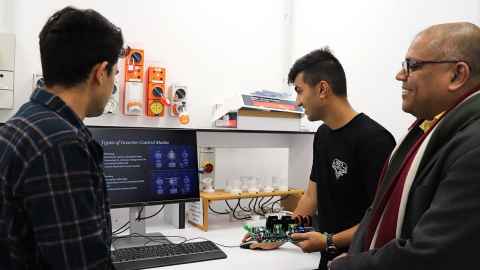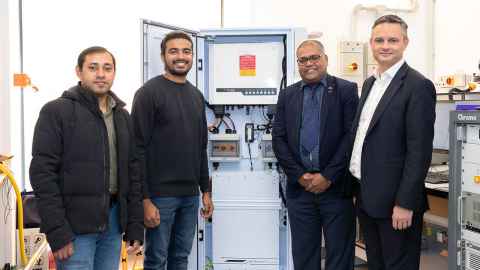Leading the charge towards change
22 June 2021
Associate Professor Nirmal Nair and his collaborators are working on several power engineering infrastructure projects geared towards Aotearoa’s climate change goals.

As government and industry begin to pursue goals towards Aotearoa New Zealand’s low-emissions future, researchers are preparing for the upcoming shifts in our energy landscape. Dr Nirmal Nair and his Power Systems research group are working on several projects to address the challenges regarding our electricity grid for the future, and looking as far forwards as 2050.
One of these major changes involves the fundamental transformation of our 130 year old electricity infrastructure.
With the exception of high voltage energy transportation between its two islands, Aotearoa’s electricity grid currently employs a predominantly AC system to transfer its power supplies to users. While this means that all buildings here supply AC power outlets, it however isn’t the case with the majority of users.
“Everything we use — electronics, home appliances, batteries — is in DC”, says Dr Nair. “Solar generation too, is in DC. You’re feeding solar energy directly into an AC grid that needs to be converted to DC to power your laptop.”
This mode of delivery is centralised, or “grid-following”. This is a reality that will see electricity resources “wasted” as we begin to accommodate renewables, or as Electric Vehicles (EVs), for example, become more prominent. We’re already seeing developments where EV battery energy and home battery systems can be shared with the electricity grid. This is also a move towards “grid-supporting”, where users can support the local grid through renewable energy resources.
To rewire our grid will be extremely costly, but he believes that change can be localised — at the neighbourhood level. At these levels, DC/AC converters will be placed in neighbourhoods that will share that resource, such as a battery. Later, they can form their own pico-grids and microgrids and become “grid-forming”.
This change raises plenty of questions.
This is why we are also talking about resilience. We’re not just focusing on how viable these solutions can be economically, but on how everything will operate together.
The Department of Electrical, Computer, and Software Engineering is also in the midst of revising its undergraduate curriculum to ensure that students can pursue electives from across their three specialisations. They aim for a stronger focus on flexibility and industry-grade knowledge in relevant technologies.

This helps each of their BE(Hons) specialisations to align with the interdisciplinary nature of the challenges presented to research and industry — from the cybersecurity policies within grid networks and optimising what’s possible with our built infrastructure, to the communication networks between grid clusters, and more. Emerging innovations within the space of renewables creates new opportunities, and engineering students are well-positioned to address the developments to come.
Being in Power Engineering means that I come from the traditions of Tesla and Edison. We want to unleash this innovative spirit here and now so we can create new industries and professions. It’s possible within this field to start your own thing and contribute towards the well-being of humanity and the environment.
Over the last year, the department has relocated to our new Engineering Building 405, aimed at reimagining the way we teach and learn. For Dr Nair, this meant developing a future-proof research facility as well as a “living laboratory”. Investments were made in equipment that emulates our home power systems, and more notably, their own DC microgrid integrated into the building itself. Solar power will be collected on the roof of Building 405, so the lab is receiving DC power directly.
The facilities are also equipped for “grid-following” testing: battery emulators, high-powered DC sources, grid simulators, as well as an upcoming proposal to acquire real-time digital simulators. Some of their research involves stress-testing and modeling work to determine how different energy sources will interact with a real grid.
“This isn’t just experimental”, Dr Nair suggests. “We’re set up to see how all of this can work in the real-world.” This also allows the lab to function as a training facility. “Not every university has a high risk lab like ours. Students are following national standards in health and safety guidelines”, so they are provided with hands-on opportunities to learn and understand how to operate in their future work environments.

This combination of reputable expertise and facilities is what attracts the attention outside of academia itself. A recent industry collaborator is solarZero, a local solar energy services provider. This involved the installation of solarZero’s platform for R&D work in battery development for the safe, stable distribution of solar energy around homes in Aotearoa. A large solarZero battery in the Power Systems lab is being tested to see if transmission systems can be automatically restored in the event of ‘a glitch’ caused by events such as storms.
Two PhD students are working with the company, with a long-term goal of developing a foolproof system for large-scale grid support services, as well as a move towards a more compact battery. Several undergraduate students are also working on a Part IV project to understand guidelines and policies for neighbourhood grids. A milestone involved a visit from Minister of Climate Change James Shaw just weeks before He Pou a Rangi/the Climate Change Commission published its advice on how Aotearoa can meet its emissions targets.

Dr Nair’s supervision portfolio, ranging from undergraduate students to masters and PhDs, forms the support infrastructure for upcoming tech companies who are in need of expertise and technology as we move towards the zero-carbon, “grid-forming” architecture of the future. “Our science is further ahead than what exists now and we’re socialising our students with new innovations; we’re looking to 2050”, he says, emphasising on Kiwi researchers and companies taking hold of their future as these technologies begin to scale upwards.
We’re in this period where policy and green innovation is coming together to change the way we work, so now is the right time to invest in this expertise.
“Ultimately, this is all public good research”, he adds. “We are developing technology not just for New Zealand, but also the world, and finding solutions towards decarbonising rapidly as we speak.”